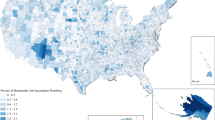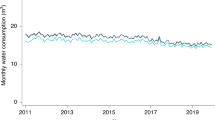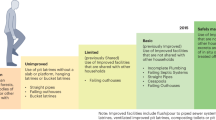Abstract
Background
While the Safe Drinking Water Act allows states and localities to adopt stronger protections for drinking water, state and local requirements concerning private drinking water wells vary dramatically and often do not provide necessary protections for residents who rely on well water.
Objective
This paper inventories ten types of policies including laws, regulations, programs, and activities that states have adopted or partaken in to encourage safe drinking water for residential well owners.
Methods
To identify categories of private well protections, we conducted a preliminary internet search with key search terms to create an initial list of 10 categories of laws, regulations, programs, and activities (collectively referred to as “policies”) that states have taken to protect residential well water quality. To have a private well safety category present, the law, regulation, program, or activity must fit within the scope of the ten classifications. To limit the breadth of our search, we excluded local and county protections, as well as activities by non-governmental organizations. We also excluded basic construction standards for new wells and licensing standards for well drillers, both of which are covered under a previous study. We conducted an additional internet search to complete a comprehensive review of each state and category and to validate our previous findings. In addition to this internet search, we completed phone and email outreach to the state agencies implementing the well safety categories identified in our internet search to confirm our results.
Results
The results indicate a wide range of state-based well water protections. The number of residential well water protections present in each state ranged from 8 policies in Iowa, Kentucky, and Maine to 1 policy in Oklahoma, with a median of 5 policies across the 50 states.
Impact
-
This paper examines protections that states have implemented to safeguard residential well water quality and to protect the health of people who rely on well water. This research reviews state-level regulations, laws, and programs, as opposed to local, municipal, county-level, or quasi-governmental protections for residential well owners. Residential well policies were examined across ten categories. Without any protections at the federal level, this research reveals gaps in state regulation and demonstrates the need for broader adoption of comprehensive state-level policies to better protect residential well owners from drinking water contaminants and their associated public health impacts.
This is a preview of subscription content, access via your institution
Access options
Subscribe to this journal
Receive 6 print issues and online access
$259.00 per year
only $43.17 per issue
Buy this article
- Purchase on Springer Link
- Instant access to full article PDF
Prices may be subject to local taxes which are calculated during checkout


Similar content being viewed by others
Data availability
Data were collected via online Google search and through phone and email interviews with relevant government agency staff. For online results, various government agency web pages were used. Further information can be requested via the authors who can provide contact information for the relevant government agency staff, or provide the relevant statute or applicable website link for each well safety category present.
References
Bowen K, Krishna T, Backer L, Hodgins K, Waller LA, Gribble MO. State-level policies concerning private wells in the United States. Water Policy. 2019. https://doi.org/10.2166/wp.2019.205.
Malecki K, Schultz A, Severtson D, Anderson H, VanDerslice J. Private-well stewardship among a general population-based sample of private well-owners. Sci Total Environ. 2017;601–2:1533–43.
Murray R. The Lower Shore Safe Well Water Initiative (LSSWWI): a community science project for water quality surveillance in Maryland’s lower eastern shore, In: Proceedings of American Public Health Association annual conference, 7 Nov 2022; virtual.
Jurgens B, Parkhurst D, Belitz K. Assessing the lead solubility potential of untreated groundwater of the United States. Environ Sci Technol 2019;53:3095–103.
Ransom KM, Nolan BT, Stackelberg PE, Belitz K, Frama MS. Machine learning predictions of nitrate in groundwater used for drinking supply in the conterminous United States. STOTEN. 2022;807:151065.
Bradley PM, Kolpin DW, Thompson DA, Romanok KM, Smalling KL, Breitmeyer SE, et al. Juxtaposition of intensive agriculture, vulnerable aquifers, and mixed chemical/microbial exposures in private-well tapwater in northeast Iowa. https://doi.org/10.1016/j.scitotenv.2023.161672.
United States Environmental Protection Agency. Frequent Questions on Septic Systems. [Internet] [updated 2022 Aug 23]; Available from: https://www.epa.gov/septic/frequent-questions-septic-systems. Accessed 6 Jan 2023.
Schaider LA, Ackerman JM, Rudel RA. Septic systems as sources of organic wastewater compounds in domestic drinking water wells in a shallow sand and gravel aquifer. STOTEN. 2016;547:470–81.
Bremer JE, Harter T. Domestic wells have high probability of pumping septic tank leachate. Hydrol Earth Syst Sci. 2012;16:2453–67.
DeSimone LA, Hamilton PA, Gilliom RJ. Quality of water from domestic wells in principal aquifers of the United States, 1991–2004 overview of major findings. United States Geological Survey; 2009; Available from: https://pubs.usgs.gov/circ/circ1332/. Accessed 24 Jan 2023.
United States Environmental Protection Agency. Information about Public Water Systems. [Internet] [updated 2022 Nov 15]; Available from: https://www.epa.gov/dwreginfo/information-about-public-water-systems. Accessed 6 Jan 2023.
Maryland Code, Env. § 9-4A-01 (2021).
New Jersey Statutes Ann., § 58:12A-27 (2001).
Individual Water Systems 1981 (Salt Lake County Board of Health) Health Regulation 11.
United States Center for Disease Control. Well Testing. [Internet]; Available from: https://www.cdc.gov/healthywater/drinking/private/wells/testing.html. Accessed 17 Jan 2023
Iowa Code, §455E (2016).
Wisconsin Department of Natural Resources. Well Compensation Grant Program. [Internet]; Available from: https://dnr.wisconsin.gov/aid/WellCompensation.html. Accessed 28 Jan 2023.
Florida Bureau of Environmental Health. Well Surveillance Program. [Internet] [updated 2023 Jan 30]; Available from: https://www.floridahealth.gov/environmental-health/drinking-water/well-surveys.html#:~:text=The%20Well%20Surveillance%20Program%20protects,consumption%20of%20contaminated%20drinking%20water. Accessed 1 Feb 2023.
Maryland Department of Environment. Groundwater Protection Program Report to the Maryland General Assembly. [Internet] [updated 2021 Dec 1]; Available from: https://mde.maryland.gov/programs/water/water_supply/Documents/GroundwaterProtectionReport-2021-Dec.pdf. Accessed 1 Feb 2023.
Illinois Environmental Protection Agency. Illinois Groundwater Protection Act. [Internet]; Available from: https://www2.illinois.gov/epa/topics/water-quality/groundwater/wellhead-protection/Pages/report.aspx. Accessed 1 Feb 2023.
Texas Water Code, §26.408 (2003).
Oklahoma State University Extension. Cracking the case on rural well water. [Internet] [updated 2021 Oct 20]; Available from: https://extension.okstate.edu/articles/2021/rural-water-2.html. Accessed 2 Feb 2023.
Mills K, Pope A Private well owner network effort began with free water screenings in rural Oklahoma. KOSU NPR [Internet]. 2022; Available from: https://www.kosu.org/local-news/2022-07-06/private-well-owner-network-effort-began-with-free-water-screenings-in-rural-oklahoma. Accessed 1 Feb 2023.
Maine Revised Statute, §2660-W (2017).
Acknowledgements
Assistance comes from various government agencies, including the Arkansas Department of Public Health, Idaho Department of Environmental Quality, Illinois Department of Public Health, Indiana Department of Public Health, Iowa Department of Natural Resources, Kansas Department of Health and Environment, Kentucky Energy and Environment Cabinet, Michigan Department of Health and Human Services, New Hampshire Department of Environmental Services, New Jersey Department of Environmental Protection, New Mexico Environment Department, North Carolina Department of Health and Human Services, Division of Public Health, North Dakota Environmental Quality, and the Oklahoma Department of Environmental Quality.
Funding
Sophie Loeb and Katlyn Schmitt are supported by the Center for Progressive Reform. Mary H. Ward is supported by the Intramural Research Program of the National Cancer Institute, National Institutes of Health (Project Z01 CP01012522). Darya Minovi has no funding to disclose.
Author information
Authors and Affiliations
Contributions
Sophie Loeb assisted with data collection for the private well data spreadsheet, which was used to create Figs. 1, 2. Loeb also assisted in the authoring of the manuscript. Darya Minovi assisted in the authoring of the manuscript. Katlyn Schmitt created the private well data spreadsheet and assisted with the data collection. Schmitt also assisted in the authoring of the manuscript. Mary H. Ward reviewed, provided input into the manuscript content, and authored portions of the paper related to the importance of state-level well water protections and water quality.
Corresponding author
Ethics declarations
Competing interests
The authors declare no competing interests.
Ethical approval
Ethical approval was not required for this research as no human or animal subjects were used, nor were private, protected, or culturally significant research locations used.
Additional information
Publisher’s note Springer Nature remains neutral with regard to jurisdictional claims in published maps and institutional affiliations.
Rights and permissions
Springer Nature or its licensor (e.g. a society or other partner) holds exclusive rights to this article under a publishing agreement with the author(s) or other rightsholder(s); author self-archiving of the accepted manuscript version of this article is solely governed by the terms of such publishing agreement and applicable law.
About this article
Cite this article
Schmitt, K., Minovi, D., Loeb, S. et al. A state-by-state comparison of policies that protect private well users. J Expo Sci Environ Epidemiol 34, 155–160 (2024). https://doi.org/10.1038/s41370-024-00645-2
Received:
Revised:
Accepted:
Published:
Issue Date:
DOI: https://doi.org/10.1038/s41370-024-00645-2
Keywords
This article is cited by
-
Assessing exposure and health consequences of chemicals in drinking water in the 21st Century
Journal of Exposure Science & Environmental Epidemiology (2024)



